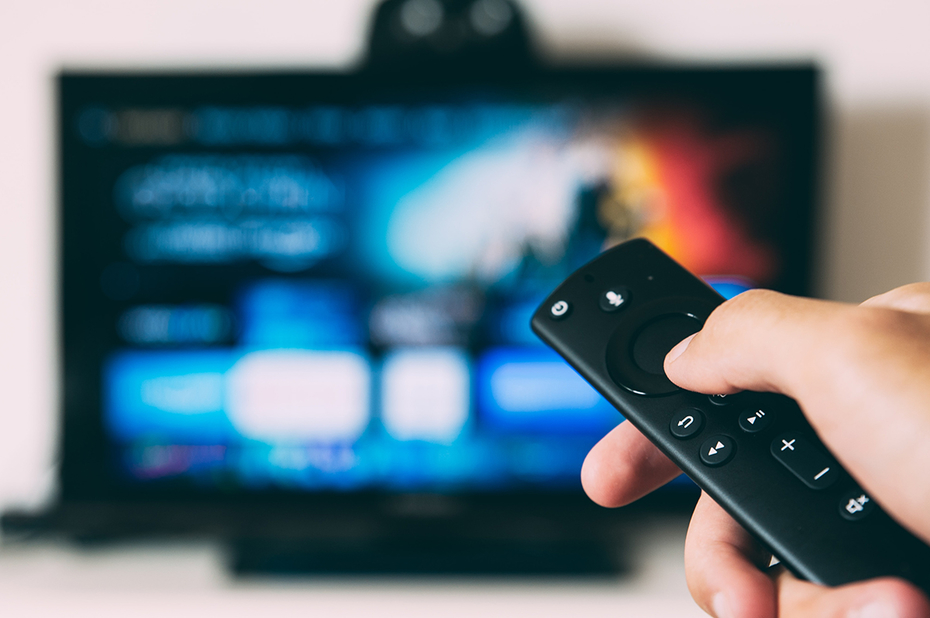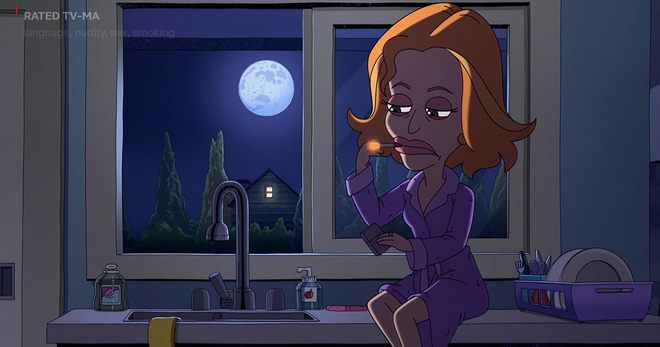
Straight to vape
Pervasive tobacco imagery in popular shows poses new threat, making youth more prone to e-cigarette use
The resurgence of tobacco imagery in episodic content – where it is often portrayed as a normal social behavior and as glamorous, rebellious and edgy — poses a new threat to young people. A groundbreaking new Truth Initiative study finds that youth and young adults with high exposure to popular streaming and TV shows containing tobacco images are three times more likely to start vaping compared to their peers with no exposure. This new research comes as young people’s favorite shows continue to prominently feature tobacco, according to the latest Truth Initiative analysis, and as the popularity of streaming grows even more rapidly amid the COVID-19 pandemic with many young people spending more time at home. With youth e-cigarette use already at epidemic levels, it is clear that tobacco content on the small screen is a growing and urgent health risk for young Americans.
While a robust body of research has directly linked tobacco imagery in movies to increased smoking among young people, the new Truth Initiative study is the first to establish a link between smoking imagery and e-cigarette use, finding that exposure to tobacco imagery through episodic programming can triple a young person’s odds of starting to vape. The research also found that the higher the exposure, the greater the odds of subsequent vaping initiation — a concerning finding in the age of binge-watching — and that younger age was also linked with increased likelihood of starting to use e-cigarettes. Published in Preventive Medicine, the nationally representative study used a sample of 4,604 youth and young adults between ages 15-24 who had never previously used e-cigarettes or any other tobacco product.
This new vaping evidence adds urgency to an issue Truth Initiative first reported on with its landmark 2018 study, “While You Were Streaming: Tobacco Use Sees a Renormalization in On-Demand Digital Content, Diluting Progress in Broadcast & Theaters,” that sounded the alarm on the pervasive re-normalization of tobacco images in streaming, broadcast and cable shows most popular among youth and young adults. The follow-up report in 2019, “While You Were Streaming: Smoking on Demand,” found that the picture had gotten worse with streaming platforms like Netflix continuing to feature massive amounts of tobacco imagery. Smoking on the small screen had gone from common to nearly unavoidable, as popular programs like “Stranger Things,” “Orange Is the New Black” and “Modern Family” increasingly show images of tobacco and portray characters who smoke.
The alarming data connecting tobacco imagery with vaping behavior directly build on prior While You Were Streaming reports. Researchers asked participants how often they watched a selection of nine shows previously identified as representing programs with high, low and no amounts of tobacco imagery. These programs included “Big Bang Theory”, “Daredevil”, “Once Upon a Time”, “American Horror Story”, “Modern Family”, ‘Fuller House”, “Orange is the New Black”, “The Walking Dead”, and “Stranger Things” and surveys were conducted between February and May 2018. A year later, researchers asked about tobacco product use. The subsequent finding — that high exposure to tobacco imagery through episodic programming triples a young person’s odds of starting to vape — underscores that tobacco imagery in video content continues to put young people at risk.
Compounding the threat: tobacco imagery continues to appear prominently in young people’s favorite shows. In this 2020 report, “Straight to Vape: Pervasive Tobacco Imagery in Popular Shows Poses New Threat, Making Youth More Prone to E-Cigarette Use,” Truth Initiative finds nearly three-quarters — 73% — of the top 15 most popular programs with 15- to 24-year-olds feature characters who smoke or depict tobacco products, effectively exposing more than 27 million young people to tobacco in 2019. The top offender from Truth Initiative’s two previous reports, hit Netflix show “Stranger Things,” topped the list again with four times as many depictions of tobacco in its latest season compared to its first season. Seven of the shows analyzed were rated TV-G or TV-PG, and instances of tobacco depictions nearly doubled in youth-rated shows between the 2018 and 2019 seasons. This preponderance of tobacco in episodic content is part of an overall problem with the renormalization and glamorization of tobacco in entertainment media and pop culture – recent research has also reported an increase in tobacco imagery in top-grossing movies.

Exposure to tobacco imagery through episodic programming triples a young person’s odds of starting to vape.
As the youth vaping epidemic drives overall youth tobacco use to levels unseen in nearly two decades, it is no surprise that the evidence shows that tobacco imagery in entertainment increases youth and young adult e-cigarette use. Vaping is the dominant type of tobacco use today among young people and is often the first tobacco product tried. Youth e-cigarette use has skyrocketed in recent years, doubling among high school students, from 11.7% in 2017 to 27.5% in 2019; and tripling among middle school students from 3.3% to 10.5%. On top of growing evidence that e-cigarettes harm lung and heart health, young people who use e-cigarettes are four times more likely to start smoking cigarettes than their peers who do not vape. Nicotine in all forms is harmful to developing brains: younger users are more likely to become addicted, have more difficulty quitting and may be at higher risk for addiction to other substances in the future. Tobacco use is also putting youth at higher risk during the COVID-19 public health crisis: new research shows that smoking or vaping may increase the risk of needing intensive care or even dying from COVID-19.
“Truth Initiative has been sounding the alarm on the resurgence and renormalization of tobacco imagery on the small screen and its negative impact on youth for years. These new data definitively linking tobacco imagery in episodic programing to youth vaping initiation both validates and escalates our concerns. Put simply, the more tobacco use a young person sees in shows, the more likely they are to start vaping,” said Robin Koval, CEO and President of Truth Initiative. “We feel an increased sense of urgency knowing that tobacco content is directly fueling the youth vaping epidemic. As Big Tobacco reinvents itself with electronic products that put a new generation of young people at risk for nicotine addiction, the entertainment industry should not be complicit and must do more. It’s critical to know where tobacco content exists and to implement policies that can limit ongoing tobacco exposure.”
It’s all about the vape: the new frontier of smoking
The Truth Initiative study published in Preventive Medicine and its main finding that young viewers who watch more tobacco-containing shows have over three times the odds of subsequent vaping reflects major shifts in both the media and tobacco product landscapes.
Many previous studies have clearly linked tobacco depictions in movies with youth smoking, prompting the Surgeon General to issue a report in 2012 stating conclusively that exposure to onscreen smoking in movies causes young people to start smoking. This new Truth Initiative study highlights a shift in the influence of tobacco imagery that follows trends in product usage. Even while most on-screen depictions still feature cigarettes and smoking, the behavior it fuels among young people is toward e-cigarettes. This result makes sense given the current culture – after years of progress to decrease the smoking rate, cigarettes have now been replaced by e-cigarettes among youth as socially acceptable and the first tobacco products tried. Young people may be imitating the behavior of smoking, but with the more popular product among their generation.
While the media landscape and types of tobacco products have changed over the years, the influence of tobacco in pop culture on young people has not. Concerns, however, have grown more urgent given the youth e-cigarette epidemic and the increased health threats posed by the COVID-19 pandemic.
COVID-19 HELPS PAVE WAY TO MORE TOBACCO EXPOSURE
The COVID-19 pandemic has contributed to a set of precarious conditions for youth exposure to tobacco use in media. The closure of schools and the cancellation of many youth engagement activities have given many young people more free time to consume content. In the first month of stay-at-home orders, in March 2020, the U.S. audience for streaming channels grew by 50-60%, with children and teen viewers growing by nearly two-thirds, according to Nielsen tracking. This adds up to millions of young eyeballs on shows that feature the use of tobacco, which in turn makes them three times more likely to try vaping.
The pandemic accelerated an already rapid ascent in streaming, which has gained popularity in recent years as new platforms proliferate and provide more content for viewers. In 2019, U.S. media and entertainment companies spent over $120 billion on original content. Netflix alone increased its original content by more than 50% in 2019, releasing 371 original TV shows and movies in the U.S. Streaming now accounts for nearly 20% of television consumption for most Americans, almost doubling its 2018 market share. And the percentage of youth reporting that their most-watched shows aired on streaming platforms rose from 29% in 2018 to 84% in 2019.

Streaming now accounts for nearly 20% of television consumption for most Americans, almost doubling its 2018 market share.
Bright Spots: Some shows demonstrate the harmful effects of vaping
Though not among young people’s favorite shows, some programs have highlighted the negative health consequences of e-cigarette use, including storylines about vape-related lung injuries on “Grey’s Anatomy,” “New Amsterdam,” “Upload” and “Chicago Med.” Grey’s Anatomy, for example, contained no tobacco imagery at all and also featured a story with a 17-year-old swimmer whose lungs resembled those of a 60-year-old smoker due to vaping. The impact of possible anti-vaping messages embedded within episodic programming is unclear but should be studied to best discourage tobacco use.
FREQUENT DEPICTIONS OF TOBACCO IN POPULAR SHOWS
As young people spend more time streaming their favorite shows, those programs remain likely to include some type of tobacco product.
Following the first two Truth Initiative reports that uncovered the pervasiveness of tobacco imagery in popular shows, the latest analysis finds that a majority of shows still contain tobacco. An analysis of the top 15 programs among 15- to 24-year-olds from 2018 and 2019 finds that tobacco continues to regularly appear onscreen, with 73% featuring characters who smoke or depicting tobacco products.
The use of e-cigarettes in shows is rising and often depicted as cool and sexy. Among the top shows popular with young people, depictions of e-cigarette use increased in 2019. In 2018, there were 16 instances of e-cigarettes in three top shows: “Big Mouth” (6), “Family Guy” (6) and “Fuller House” (4). Five shows featured 22 e-cigarette instances in 2019, including “Big Mouth” (11), “On My Block” (6), “Black Mirror” (3), “You” (1) and “Black-ish” (1). Almost all (98.9%) vaping instances across 2019 shows analyzed by Truth Initiative featured characters actively using products either in their hands or mouths.
Truth Initiative survey results also found that an estimated 2.5 million youth and young adults, including over 400,000 youth ages 13-17, watched season one of HBO’s “Euphoria,” which had 67 incidences of e-cigarette use across eight episodes.
While e-cigarettes are creeping into popular shows, cigarette imagery still dominates the screen. Season 3 of “Stranger Things” included 721 tobacco incidences in its latest season — quadrupling the instances of tobacco imagery in the show’s first season. “Shameless” was at the top of the list in 2018 with 226 depictions of tobacco. “The Simpsons,” “Family Guy,” and “Big Mouth” each had over 50 tobacco incidences in their respective 2018 seasons and “Orange is the New Black” — another repeat offender from previous reports — had 38. The “End of the F***king World” had 1,000+ tobacco images in a single “powerwall” scene (large display of tobacco products) that featured hundreds of cigarette packs and individual tobacco products. (See charts on page 7 for a complete list of tobacco incidences in the top 15 shows*).
Not only do many shows contain tobacco, but they also feature it repeatedly. Over 50% of 2019 shows that included tobacco depictions featured it in more than half of all episodes. “Shameless” featured tobacco content in every single episode in 2018 and almost all 2019 episodes of “Sex Education” and “Stranger Things” contained tobacco, with 88% and 75% of episodes, respectively, depicting tobacco use.
Over 50% of 2019 shows that included tobacco depictions featured it in more than half of all episodes.
Tobacco incidences appeared even in streaming shows designed for general audiences (TV-G) and for younger viewers to watch with their parents (TV-PG). Seven of the shows analyzed for this report were rated TV-G or TV-PG and tobacco depictions in these shows nearly doubled from 576 incidences in 2018 to 1,156 in 2019. TV Parental Guidelines do not currently treat tobacco as an explicit rating factor, making it more challenging for parents to help their children avoid content that makes them more likely to smoke or vape.
Seven of the shows analyzed for this report were rated TV-G or TV-PG and tobacco depictions in these shows doubled from 576 incidences in 2018 to 1,156 in 2019.

HOW RESEARCHERS SELECTED AND ANALYZED SHOWS
Truth Initiative researchers surveyed over 2,000 young people (ages 15-24) to identify the most popular shows among young people in 2018 and 2019.*
|
Top 2018 shows among ages 15-24, by popularity** |
Top 2019 shows among ages 15-24, by popularity** |
|
Family Guy, Season 16 (FOX) |
Stranger Things (Netflix) |
|
Simpsons, Season 29 (FOX) |
13 Reasons Why (Netflix) |
|
Walking Dead, Season 8 (AMC) |
The Big Bang Theory (CBS) |
|
Bob’s Burger, Season 8 (FOX) |
Big Mouth (Netflix) |
|
Big Bang Theory, Season 11 (CBS) |
Orange is the New Black (Netflix) |
|
Criminal Minds, Season 13 (CBS) |
You (Netflix) |
|
Modern Family, Season 9 (ABC) |
On My Block (Netflix) |
|
Law and Order: SVU, Season 19 (NBC) |
Lucifer (Netflix) |
|
Big Mouth, Season 2 (Netflix) |
Fuller House (Netflix) |
|
NCIS, Season 15 (CBS) |
The End of the F***ing World (Netflix) |
|
13 Reasons Why, Season 2 (Netflix) |
A Series of Unfortunate Events (Netflix) |
|
Orange is the New Black, Season 6 (Netflix) |
Black Mirror (Netflix) |
|
Riverdale, Season 2 (CW) |
The Mandalorian (Disney+) |
|
Shameless, Season 8 (Showtime) |
High School Musical: The Series (Disney+) |
|
Fuller House, Season 4 (Netflix) |
Sex Education (Netflix) |
Reviewing shows for tobacco:
Researchers viewed more than 700 episodes and 400 hours of programming to document tobacco depictions. Each image of a cigarette pack or individual product was counted as a separate incident — even if multiple packs or products were shown in the same scene. Researchers coded 415 episodes from the top 2018 shows and 305 episodes from the top 2019 shows for the presence of tobacco.
*Shows that aired new episodes as of January of each year were included in the survey
**Top shows were identified by Truth Initiative surveys. Researchers used Nielsen viewership data for the target age group to determine which cable and broadcast shows to include in the survey. For streaming platforms, researchers identified scripted, original shows that demonstrated youth appeal and cross-referenced the selections with social media and news articles. In total, more than 150 shows per year were included in the surveys. The top 15 shows differ in 2018 and 2019 because some did not air each year and some gained popularity over time.
A MULTI-PLATFORM PROBLEM: TOBACCO IMAGERY IN ENTERTAINMENT AND POP CULTURE
Broadcast/cable TV and streaming networks are not the only entertainment platforms littered with tobacco imagery. The big screen is a big part of the problem as well. Researchers at the University of California, San Francisco released a report earlier this year showing that tobacco incidences in movies in 2019 were the highest in more than a decade. More than half of top-grossing films released in 2019 depicted tobacco use, resulting in 23.7 billion in-theater tobacco impressions alone — which doesn’t include exposures from at-home movie viewing. Unfortunately, youth-rated films are not exempt from this influential imagery, and in fact, the amount of tobacco content has risen in youth-rated movies by 63% since 2015 alone.
Peer-reviewed studies estimate 37% of new youth smoking initiation in the U.S. can be attributed to exposure to smoking in movies. According to the U.S. Surgeon General, exposure to tobacco use on screen causes young people to smoke. The CDC predicts that this will lead to more than 6 million new youth smokers, a third of whom will die from tobacco-related diseases.
While cigarettes are the primary form of tobacco imagery on the big screen, the presence of e-cigarettes in movies has skyrocketed too. Among top-grossing movies released in 2019, there were 116 e-cigarette incidences, which is more than half of the total e-cigarette depictions in history (204 total incidences). E-cigarettes were first documented to appear on screen in 2010 and while movies with e-cigarettes from major studios are mostly R-rated, the same is not true for independent movies that show vaping — most of those movies receive youth-appropriate ratings.
Other types of entertainment media geared toward young people often portray tobacco as well. Tobacco imagery is widespread in video games played by youth and 93.5% of popular video games that contain tobacco images portray its use in a positive or neutral light, according to previous Truth Initiative research. Popular music videos are also sources of tobacco content. For example, a 2020 music video for #1 Billboard song “Blinding Lights” from The Weeknd repeatedly shows the singer smoking a cigarette. The e-cigarette KandyPen was featured in DJ Khaled’s video “I’m the One,” a collaboration with Justin Bieber, Quavo of Migos, Chance the Rapper, and Lil Wayne. The video, which has more than 1.4 billion views on YouTube, features bikini-clad models vaping KandyPens.
With this constant bombardment of tobacco use in entertainment— alongside an overwhelming increase in total viewership — Big Tobacco has more opportunities to ensnare youth into a lifetime of tobacco use. With a clear link between tobacco imagery and youth vaping, it is more important than ever that all content providers implement strong policies designed to protect youth from exposure to tobacco depictions on screens — from laptops to phones and from TVs to movie screens.
PROTECTING YOUNG PEOPLE FROM TOBACCO IMAGERY
Tobacco use continues to appear on the small screen at an alarming rate, leading to potentially deadly consequences. With a clear link between viewing tobacco imagery on shows and subsequent e-cigarette use and combustible tobacco use among young people, the stakes have never been higher. Similar to the link between movies and cigarette smoking initiation, the more tobacco imagery young people see, the more likely it is that they will vape and begin a trajectory to nicotine addiction and other tobacco use.
Media companies have taken some steps aimed at reducing tobacco imagery in shows but more must be done. Following the publication of our 2019 report, Netflix announced in 2019 that it would eliminate tobacco in youth-rated programming (rated TV-14 or below) going forward and that it plans to cut back on depictions across the board. The streaming giant determined that 190+ of its original TV series contained tobacco content, and added a smoking warning label at the beginning of certain programs. These moves, however, aren’t nearly enough. The company’s pledge has many loopholes and inconsistencies, including a caveat for creative vision and an exemption for existing shows, and a formal policy remains to be seen. An example of the weakness in this policy is illustrated by Netflix’s newly acquired series Cobra Kai (not rated), which includes blatant smoking and cigarette brand display.
Other online streaming services must address the problems on their platforms as well. For example, few provide viewers with consistent information about tobacco content. Smokefree Movies at the University of California, San Francisco reviewed popular U.S. streaming services and found that three streaming services do not display reasons for film and TV ratings with video content, and six other services only show reasons for TV ratings after the user begins playing the movie/TV show. They also found that none of the streaming services inform users that smoking on screen harms young viewers.
The National Association of Attorneys General has also expressed concerns about tobacco imagery in streaming content. In August 2019, the organization sent letters to major U.S. streaming services to urge the industry to implement measures to protect young people from tobacco imagery. The letters, which 43 state and territory attorneys general signed, were sent to Amazon.com, Apple, AT&T, CBS Corporation, Comcast Corporation, Discovery, The Walt Disney Company, Google, Netflix, Sony, Lionsgate, Viacom and Walmart.
To help halt the vaping epidemic in its tracks, Truth Initiative calls for a comprehensive set of policies to curb tobacco incidences on screen that increase the likelihood that young people will start vaping. They include:
- Ratings system – Designating new titles with smoking as TV-MA — designed for adults and unsuitable for those 17 and under — could reduce young people’s exposure to tobacco. TV Parental Guidelines, which do not currently treat tobacco as an explicit rating factor, would provide more clarity and information for parents who seek to limit the tobacco content their children consume.
- Anti-tobacco and anti-vaping ads – Anti-tobacco messages have been enormously successful in reducing tobacco use rates and should be deployed before and during shows that feature tobacco imagery. These messages should include specific anti-smoking and anti-vaping messages that demonstrate the harmful effects of this increasingly popular tobacco product.
- Tobacco payoffs – Big Tobacco has an overt interest in the continued presence of tobacco on TV. It is essential to ensure that no parties or persons involved with a production received anything of value in exchange for including smoking or vaping depictions in a show.
- State public subsidy policies – Shows with tobacco depictions should not be eligible for local production subsidies, including tax breaks and other incentives. States can change their production subsidy policies to provide tax and other incentives for only those productions that do not promote tobacco use.
- Education and outreach – Many creatives in the entertainment industry do not realize the potentially deadly effects that tobacco content can have on youth and young adults. It is important to educate directors, writers and producers about the importance of keeping tobacco out of their shows.
- Ongoing research – More information is available about the harmful effects of tobacco imagery than ever before, yet there is more to be learned. A rigorous and ongoing monitoring of tobacco imagery, including how it is portrayed and who is watching, is needed. Especially, with e-cigarette depictions on the rise, it is critical to document and understand the impact of streaming on youth culture and the many ways that it can impact youth health.
Today’s youth are using tobacco products, especially e-cigarettes, at unprecedented levels. Frequent tobacco imagery in the most popular entertainment among youth threatens to not only normalize tobacco use but can actually lead young people to start vaping. Network and streaming channels alike must implement measures to curb tobacco depictions before another generation loses millions to the harmful effects of tobacco use. But with strong policies and an intentional reduction in tobacco incidences throughout the entertainment industry, we have the opportunity to improve youth health outcomes and make smoking, vaping and nicotine use a thing of the past.

Network and streaming channels alike must implement measures to curb tobacco depictions before another generation loses millions to the harmful effects of tobacco use.
More in tobacco in pop culture
Want support quitting? Join EX Program
By clicking JOIN, you agree to the Terms, Text Message Terms and Privacy Policy.
Msg&Data rates may apply; msgs are automated.





